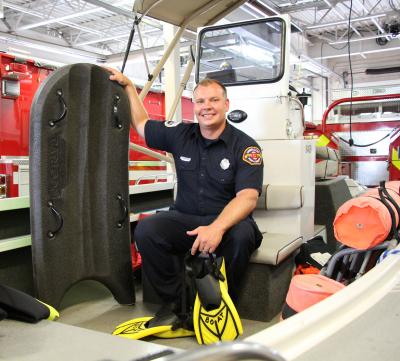CFD Special Rescue Team Conducts Water Rescue on the Willamette River
The call came in on an unseasonably hot day in June: “Swimmer in distress on the Willamette River.” After the call was dispatched, the Corvallis Fire Department’s C Shift swung into action. Emergency vehicles from Station 1 and Station 4, including an ambulance, a fire engine, and a truck hauling the department’s Special Rescue Team motorboat, sped south to the boat ramp at Crystal Lake.
Inside, CFD Engineer Leo Onderko, a member of the Special Rescue Team (SRT), was pulling on his wetsuit and swim rescue gear as the vehicles pulled in to the boat ramp. As the designated swimmer for the SRT, it was his job to jump in and provide direct aid during water emergencies. Leo wasn’t sure what to expect this time. Oftentimes, water calls involve nothing more than a little assistance from CFD to overturn a swamped canoe or overturned paddleboard.
This time, though, was different. Paramedics on scene had already spotted the victim in the water.
“The current had pushed him up under some low-hanging branches,” Leo recalled. “He was holding on, but I could tell he was absolutely exhausted.”
With the clock ticking, Leo plunged into the water, using his swim fins to get downstream to the victim. The stricken swimmer was clinging to a drooping tree branch in an awkward position that barely kept his head above the water. The victim wasn’t wearing a life jacket, and his terrified mental state meant he couldn’t think clearly or respond to Leo’s directions. The river was flowing so fast that it was creating a frothy wake behind the victim’s head. CFD had arrived at a critical moment — the exhausted swimmer was mere moments away from losing his grip and being swept away.
The crew from Station 1 had been trained to quickly prep and launch the rescue boat for emergencies just like this. SRT member Joe VanVeldhuizen brought the boat over to the victim, but dense overhanging branches prevented him from getting any closer. Thinking quickly, Leo asked his teammate to toss a life jacket, which he encouraged the victim to grab and hold. Once he did, another problem became apparent: the victim’s lower torso had become entangled in submerged branches. When he let go, the branches threatened to pull him into the fast-moving river.
Leo had seconds to act. With one hand holding a tree limb, he used his other hand to rip away the branches that were pulling the victim under.
“It felt like I was yanking on those branches for five or six minutes, trying to free that guy, but in reality it was probably just a few seconds,” Leo says.
But his quick action made all the difference. The victim was freed from the tangled branches, and Leo hauled him over to the SRT boat, where the crew pulled him safely onboard. The only casualties, as it turned out, were Leo’s SRT swim fins — they had been ripped off during the frantic few moments when he was battling the tangled branches.
After the operation, Leo reflected on how lucky the victim had been to have qualified SRT members on C Shift that day. He also emphasized the importance of wearing a life jacket and practicing basic personal safety when on the water.
“The river changes constantly,” Leo says. “Even a river you think you know like the back of your hand will change from year to year.”
